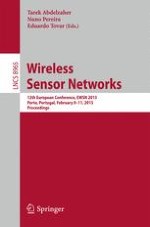2015 | Buch
Wireless Sensor Networks
12th European Conference, EWSN 2015, Porto, Portugal, February 9-11, 2015. Proceedings
herausgegeben von: Tarek Abdelzaher, Nuno Pereira, Eduardo Tovar
Verlag: Springer International Publishing
Buchreihe : Lecture Notes in Computer Science
